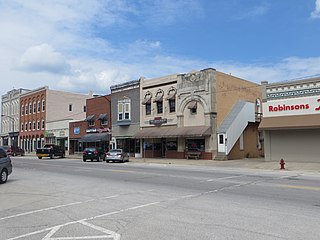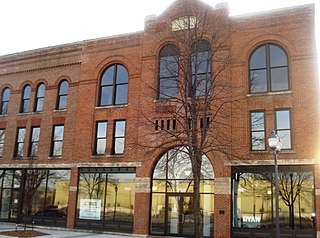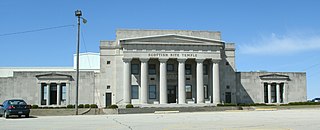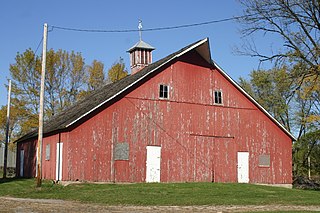Endangered historic Iowa gallery
- Fort Madison Archaeological Site
- Flooded Cedar Rapids
- Grant Wood home
Preservation Iowa, formerly called the Iowa Historic Preservation Alliance (IHPA), was founded in 1989 by members of the public concerned about the destruction of significant historic sites and buildings in the state of Iowa. [1]
Preservation Iowa sponsors two programs, Iowa's Most Endangered Properties and Preservation at its Best Awards. Currently, it is undertaking initiatives to document barns, country schools, and small-town movie theaters. [2] Preservation Iowa and the National Trust for Historic Preservation are combining efforts to document and mitigate the effects of the 2008 Iowa floods on historic structures. [3]
Preservation Iowa publishes the Iowa Preservationist quarterly.
The 2008 Preservation Iowa "Iowa's Most Endangered Properties" [4] include:

Mason City is a city and the county seat of Cerro Gordo County, Iowa, United States. The population was 27,338 in the 2020 census, a decline from 29,172 in the 2000 census. The Mason City Micropolitan Statistical Area includes all of Cerro Gordo and Worth counties. It is commonly referred to as the "River City", as the city grew up centered on the Winnebago River.

Osceola is a city in Clarke County, Iowa, United States. The population was 5,160 at the time of the 2020 census. It is the county seat of Clarke County.

Cedar Rapids is the second-largest city in Iowa, United States and is the county seat of Linn County. The city lies on both banks of the Cedar River, 20 miles (32 km) north of Iowa City and 100 miles (160 km) northeast of Des Moines, the state's capital and largest city. It is a part of the Cedar Rapids/Iowa City region of Eastern Iowa, which includes Linn, Benton, Cedar, Iowa, Jones, Johnson, and Washington counties.
Masonic Building may refer to:

May's Island is a small island on the Cedar River, in Cedar Rapids, Iowa. Functioning as a civic center much like the Île de la Cité, it is the site of the Memorial Building, the Linn County Courthouse, and the county jail. The island plus an adjacent block was listed as a historic district on the National Register of Historic Places in 1978.

The Iowa flood of 2008 was a hydrological event involving most of the rivers in eastern Iowa which began June 8 and continued until July 1. Flooding continued on the Upper Mississippi River in the southeastern area of the state for many more days. The phrase "Iowa's Katrina" was often heard.

The Len Jus Building on Federal Avenue in Mason City, Iowa was constructed in 1882. It has a rare sheet-metal facade, manufactured by the Mesker Brothers. This building has been placed on Preservation Iowa's Most Endangered list because of its poor repair and indifferent ownership.

The Masonic Building, also called the Burrows Block, Bank Block, and Masonic Temple stands on the public square in Osceola, Iowa, United States. It was constructed by banker A.H. Burrows in 1872. The upper stories of this Italianate building were used by Osceola Lodge No. 77 of the Ancient Free & Accepted Masons, and the main floor was a bank and hardware store. This building has been placed on Preservation Iowa’s Most Endangered list because of its poor repair and lack of preservation plan. It was individually listed on the National Register of Historic Places in 2010. In 2018 it was included as a contributing property in the Osceola Commercial Historic District.

The Faeth Farmstead and Orchard District is a nationally recognized historic district located near Fort Madison, Iowa, United States. At the time of its nomination it contained 27 resources, which included 15 contributing buildings, three contributing sites, three contributing structures, and six non-contributing buildings. The contributing buildings include the farm house, the main barn (1882), a stable, a privy, engine house, smokehouse, chicken house, and hog house all from the early 1900s, a shop/crib, a second barn (1925), an apple packing shed, an apple cold storage shed or cooler with loading dock, a truck shed, a garage (1950s) and a machine shed. The contributing structures include a pond that was used for spraying apples, a spray tank/house (1946), and an old section of road. The contributing sites are the three historic orchards. The East Orchard was established before 1874 and it still has remnant older trees. The Old North Orchard was established around the turn of the 20th century, but the trees were primarily planted in the 1970s and the 1980s. The North Orchard was established in 1940-1941 and includes some remnant older trees and replacement trees from the 1970s to the 1990s. The non-contributing buildings are more recently built, or moved here in recent years.

The Burlington, Cedar Rapids and Northern Railway (BCR&N) was a railroad that operated in the United States from 1876 to 1903. It was formed to take over the operations of the bankrupt Burlington, Cedar Rapids and Minnesota Railway, which was, in turn, the result of merging several predecessor lines, the construction of which began in 1869. The corporate headquarters were in Cedar Rapids, Iowa, and it had operations in Iowa and in Minnesota. It was succeeded by the Chicago, Rock Island and Pacific Railway.

The downtown district of West Branch, Iowa is part of the West Branch Commercial Historic District. Multiple architectural styles are represented. The historic and endangered Gruwell and Crew General Store is also part of the district.

The C.S.P.S. Hall in Cedar Rapids, Iowa, USA was built during 1890-91 and expanded twice in the next two decades. It was a social and cultural center of the local Czech-Slovak Protective Society (C.S.P.S.). The building was individually listed on the National Register of Historic Places in 1978. In 2002 it was included as a contributing property in the Bohemian Commercial Historic District.

Proudfoot & Bird was an American architectural firm that designed many buildings throughout the Midwest region of the United States. Originally established in 1882, it remains active through its several successors, and since 2017 has been known as BBS Architects | Engineers.

The Iowa Masonic Library and Museum, located at 813 First Ave. SE, in Cedar Rapids, Iowa, United States, is one of the largest Masonic libraries in the world and incorporates at least three museum collections. The library was the first, worldwide, to have its own building. Its current building also houses the administrative offices for the Grand Lodge of Iowa, one of the governing bodies for Freemasonry in Iowa.

The Cedar Rapids Scottish Rite Temple, also known as the Scottish Rite Masonic Center, is a historic building located at 616 A Avenue, Cedar Rapids, Iowa. It is listed on the National Register of Historic Places (NRHP) as Consistory Building No. 2

The Mesker Brothers Iron Works and George L. Mesker & Co. were competing manufacturers and designers of ornamental sheet-metal facades and cast iron storefront components from the 1880s through the mid-twentieth century. The Mesker Brothers Iron Works was based in St. Louis, Missouri, and was operated by brothers Bernard and Frank Mesker. The George L. Mesker Company was operated by a third brother, George L. Mesker, and was based in Evansville, Indiana. The Mesker brothers were the sons of John Mesker who operated a stove business in Evansville and later galvanized iron for buildings. The three brothers learned their iron-working skills from their father.

Josselyn & Taylor was an architectural firm in Iowa.

Seminole Valley Farmstead is a collection of historic farm buildings located in Seminole Valley Park on the west side of Cedar Rapids, Iowa, United States. The historic designation includes the farmhouse, summer kitchen, livestock barn, tool shed, ice house, chicken house, and smokehouse. There is also a small orchard and a garden. The complex is located near a bend in the Cedar River. The farm represents a transitional period between Iowa's austere pioneer farms and the mechanized farms that developed later in the 20th century. The nearby timber was a source of raw materials for the farm, the fertile bottomland on which it is located provided rich soil for grazing and cultivation, and the smokehouse and ice house were used to preserve agricultural products for later consumption. At the same time the barn and the chicken house were more substantial than those from earlier times. It was listed on the National Register of Historic Places in 1976.